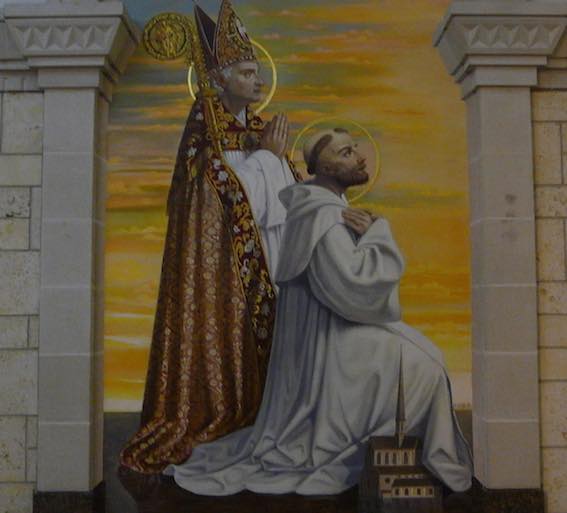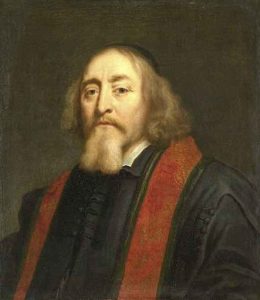The problem of forgiveness of sins
Why was Jesus’ death necessary? Could God not show mercy by simply forgiving sins without this death being necessary?
According to Anselm of Canterbury (Cur Deus Homo? = Why was God made man?), an English theologian of the 11th century, the process of forgiveness of sins cannot be simplified by comparing forgiveness among men, for personal offenses, with the forgiveness of God, the creator of the laws we transgress.
The problem of forgiveness is the clash between divine perfection and human rebellion, between a loving God who forgives and a holy and just God who judges. The solution lies at the cross where mercy and justice of God are reconciled.
The seriousness of sin
Scripture defines sin as an offense against the authority and the love of God, as a challenge to God, as a claim to independence.
It is also the refusal to face the seriousness of sin, which leads to its elimination from the vocabulary … replacing it with crime, judged by the State or by disease. But to recognize sin as sin would lead to “the awakening of personal responsibility“.
Man’s moral responsibility is commonly eliminated or reduced by a range of external factors: heredity, education, society, or a man is shaped without responsibility, predetermined by his environment. So all would be the fault of society.
Legal liability depends on the mental or moral responsibility that can be mitigated (eg for children or among the mentally disabled persons), and it depends also on the intention and the will. But the flaws of the human nature or of education cannot be an excuse.
The Bible notes that there is a tension between what influences us – original sin – and our ability to exercise our moral responsibility which is never removed. Responsibility is part of human nature and it is not offset by the fall, i.e. the Intervention of original sin, for man always keeps a minimum of power of decision.
True and false guilt
We are all without excuse because knowing what to do, we did not do it.
Romans 7.14-19
We know, indeed, that the law is spiritual; but I am carnal, unspiritual, sold as a slave to sin. I do not understand what I do: for what I want to do I do not do, but what I hate I do. Now if I do what I do not want to do, I agree that the law is good. As it is, it is no longer myself who do it, but it is sin living in me. I know that nothing good lives in me, that is to say, in my sinful nature. For I have the desire to do what is good, but I cannot carry it out. For what I do is not the good I want to do; no, the evil I do not want to do – this I keep on doing.
However, our conscience is not infallible: there is a false sense of guilt, but also a false sense of innocence, a false contrition, a false assurance of forgiveness.
Holiness and wrath of God
Sin is incompatible with God’s holiness and with his wrath which is his reluctance concerning evil and his vigorous opposition to this evil.
The Scriptures illustrated this by several metaphors: the height or transcendence, the distance, light and fire, vomiting in disgust before the disobedience of the people of Israel or the half-heartedness of the Laodicean Church.
Revelation 3.15-16
I know your deeds, that that you are neither cold nor hot. I whish you were either one or the other! So because you are lukewarm -neither cold nor hot- I am about to spit you out of my mouth.
Even if the God of our contemporaries is rather lax, we must avoid any presumption and not cut corners when we explain the work of atonement. We must keep a proper understanding of the gravity of sin and of God’s majesty.
The satisfaction for sin
Words like satisfaction and substitution provoke much criticism.
To satisfy the devil?
In the early Church, people thought it was the devil who had made the cross necessary as an instrument of his defeat. For several Fathers of the Church, the devil is the master of sin and of death, and the main tyrant from whom Jesus came to free us.
Three errors should be noted
– To give the devil more power than he actually has
– To recognize him as having certain “rights” on man
-To make the cross a barter between God and the devil.
Others define the transaction as a deception (a hook, a mousetrap).
John Stott admits some interest in these theories, but excludes any transaction and above all any deceit between the devil and God.
To satisfy the law?
The moral necessity of satisfying God with the cross is explained by the requirements of the Law, as described in the first five books of the Old Testament, especially in the Decalogue (the Ten Commandments, Exodus 20.1-17; Deuteronomy 5.6-21 ). God loves the sinners and desires to save them. The sanction required by law has been applied at the cross and thus the requirements of the Law have been met.
For the Latin fathers of the 4th century, liberation through Christ from the curse of the Law is explained by the application of the legal sentence.
Galatians 3.13
Christ redeemed us from the curse of the Law by becoming a curse for us -for it is written: “Cursed is everyone who is hung on a tree”.
For the 16th century Reformers, Christ absolutely had to submit to the Law to separate us from its condemnation. However, if the disobedience to the moral laws of God entails the condemnation, it is not because God is the prisoner of his laws, but because he is their author.
Satisfaction for the honor and the justice of God?
In Cur Deus Homo ?, Anselm rejects the patristic thesis of the ransom: it is mans debt to God that must be paid.
The only voluntary person to effect this satisfaction must necessarily be both fully God and fully man, since no one except a real God could accomplish it. And no one except a genuine man, was obliged to do that.
The Reformers stressed the notion of justice in God and the impossibility to devise a means of salvation which would not have satisfied his justice.
Hugo Grotius (1583-1645) emphasized the objective character of the cross, as the unique way to meet the demands of the divine justice. He also attached great importance to public morality in its two aspects of crime prevention and law enforcement.
Several theologians of the 20th century also applied this concept of God as a “moral governor of the world” to the doctrine of atonement. According to Emil Brunner, sin is an attack against the moral order of the world, which is an expression of the moral will of God. There is an analogy between the natural law and the moral law, none of which can be violated with impunity.
The satisfaction of God himself?
The Scriptures emphasize the perfect consistency of the person of God, who is forced to judge the sinners, while remaining true to himself, using the language of provocation, of fire, of anger. His judgment is inevitable because it is rooted in the holiness of his nature, and in perfect harmony with his requirements and his revealed nature.
Holiness and love of God
In Hosea 11 and other texts we find expressions of a duality in God, who is compassionate and grace … but who does not hold the guilty to be innocent.
For Emil Brunner the “dual” or double nature of God is the central mystery of Christian revelation. This duality is never irreconcilable, because God is not in disagreement with himself. To satisfy himself, he sacrificed himself -in substitution in our place.
God’s love and forgiveness of sin
How can God love the sinner and forgive his sins? There is no contradiction in God. His divine justice and mercy are never in conflict and do not need to be reconciled. But they are glorified by the work of Christ for the redemption of the sinners.
The sacrifice in the Old Testament prepared and prefigured the redemptive sacrifice.
The Passover and the transfer of sin
In the Passover God reveals himself as well as Judge, as Redeemer and as God of the covenant with Israel. J. Stott denounces any tendency to render meaningless the word “substitution“, by veiling the difference between repentance substitution in which the substitute offers what we could not offer and penal substitution in which the surrogate undergoes what we could not endure.
In the Old Testament to bear the sins meant to bear the criminal consequences, to suffer the penalty, even instead of another. The ritual of the two goats for atonement of sins on the Day of Atonement, makes this clear: it shows that reconciliation with God was possible only by this substitution, by this transfer of human sin on the animal.
Leviticus 16: 7-10
Then he (Aaron) is to take the two goats, and present them before the Lord at the entrance of the Tent of Meeting. He is to cast lots for the two goats – one lot for the Lord and the other lot for the scapegoat. Aaron shall bring the goat whose lot falls to the Lord and sacrifice it for a sin offering. But the goat chosen by lot as the scapegoat shall be presented alive before the Lord, to be used for making atonement by sending it into the desert as a scapegoat.
For the author of the letter to the Hebrews, Jesus is both “a merciful and faithful high priest” (Hebrews 2.17) and the perfect representative of the two victims, of the sacrificed goat whose blood was to be brought into the Holy of Holies and of the goat, on which the sins of the people were loaded and which was sent into the wilderness.
Hebrews 9.6-7, 11-12
When everything had been arranged like this, the priests entered regularly into the outer room to carry on their ministry. But only the high priest entered the inner room and only once a year, and never without blood, which he offered for himself and for the sins the people had committed in ignorance… But when Christ came as high priest of the good things that are already here, he went through the greater and more perfect tabernacle that is not man-made, that is to say, that is not a part of this creation. He did not enter by means of the blood of goats and calves, but he entered the Most Holy Place once for all by his own blood, having obtained eternal redemption.
But it was Isaiah 53 which announces most clearly the suffering and death of Christ.
The statements by Jesus himself in Mark 10.45
For even the Son of man did not come to be served but to serve and to give his life as a ransom for many.
repeat the prophecies about the Son of Man of Daniel 7. 13-14
In my vision at night I looked and there before me was one like a son of man, coming with the clouds of heaven. He approached the Ancient of Days and was let into his presence. He was given authority, glory and sovereign power; all peoples, nations and men of every language worshiped him. His dominion is an everlasting dominion that will not pass away, and his kingdom is one that will never be destroyed.
and those of the Servant of Isaiah 53. 10-12
Yet it was the Lord’s will to crush him and cause him to suffer… and though the Lord makes his life a guilt offering, he will see his offspring and prolong his days, and the will of the Lord will prosper in his hands. After the suffering of his soul he will see the light of life and be satisfied. By his knowledge my righteous servant will justify many and he will bear their iniquities. Therefore I will give him a portion with the great and he will divide the spoil with the strong, because he poured out his life unto death, and he was numbered with the transgressors, because he bore the sin of many, and made intercession for the transgressors.
The words of the Last Supper where Jesus declares that “his blood would be shed for many” (Mark 14:24) show that he was aware of wearing, in his death, the sin of men.
He takes upon himself our curse, and gives us his blessing; he becomes sin by taking on himself our sin, and we become righteous by His righteousness; but he did not become really a sinner.
These are the criminal consequences of our sins that have been transferred to him. The cross is thus a real substitutionary sacrifice: Christ died instead of us.
Who takes the place of the sinner?
Stott points out the error of seeing in Jesus Christ a human being separated as well from God as from us. Jesus Christ is not an independent third party, intervening to appease an angry God and to snatch from him a reluctantly granted salvation. Do not either give to God alone the initiative of punishing the innocent Jesus instead of the sinners who deserved that punishment. This false reasoning puts them in opposition by making Christ the object of the wrath of God and making God the one whom Christ must persuade, while both cooperate for the salvation of the sinners.
Stott shades the saying of Acts 20:28 “the Church that God has purchased with his own blood,” the blood of Jesus, of God the Son, stating that no verse of Scripture says that God would have died himself on the cross. Indeed, one can not say that God died because the New Testament means by “God” the Father and the person who went up on the cross is not God the Father, but God the Son.
The role of the persons of the Trinity in the drama of the Cross
The way the role of the different persons of the Trinity in the drama of the cross is treated is relevant and thorough. The author warns against the sometimes observed error, for example in some songs: Jesus Christ, our substitute, is made the merciful antagonist of an angry God out of whom he tries to wring the forgiveness so that the sinner escapes his judgment. No, there is no separation between the Father and the Son: the construction of a merciful Christ who pressures a reluctant God to take leniency towards us is collapsing before the reality of God’s love in all of his Trinity.
A useful review of some heresies of the first centuries of the Trinity
We also appreciate the usefulness of examining certain heresies of the first centuries of the Trinity.
Although all these controversies may seem far removed from our Christian concerns in the 21st century, we do well to keep us on our toes. These heretical tendencies may be present in some current sectarian movements.
Excessive emphasis on the suffering of God’s Son on the cross leads either to the error of the Modalists and Patripassians who confuse the persons of the Trinity and deny the eternal distinction between the Son and the Father, or to the error of the Monophysites and Theopaschites who confuse the two natures (divine and human) of Christ and deny the fact that he was a person in two natures.
Indeed, the false doctrine of William Branham or Kenneth Hagin, fashionable in some extremist circles, builds on Modalists theses: the Father, the Son and the Spirit are not distinct persons in the Godhead, but three temporal “modes” by which God would have revealed himself successively.
God in Christ
Our substitute is neither Christ alone nor God alone, because of the incarnation, but it is Jesus Christ with his double human and divine nature. According to the New Testament, atonement is performed by both the Father and the Son. God took the initiative and sent his Son for us, he acted through him and shared his suffering.
At the cross, where both amnesty and punishment, justice and mercy become manifest, there are not three actors, but two: we on one side, and God-made-man-in-Christ on the other, the death of Christ being presented as the death of the Son of God.
Thus the words “satisfaction” and “substitution” are very useful to expose the doctrine of salvation: God in Christ not only took our place, but this was the only way to allow both the satisfaction of the holy love of God and the salvation of rebellious human beings.
NB: literal or approximate quotes of John Stott are in italics.
C. Streng



